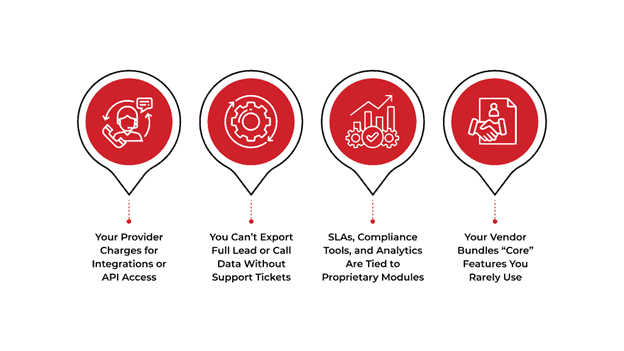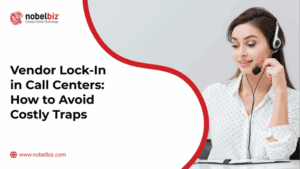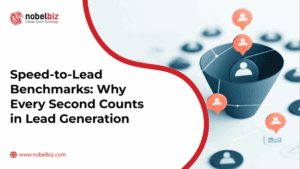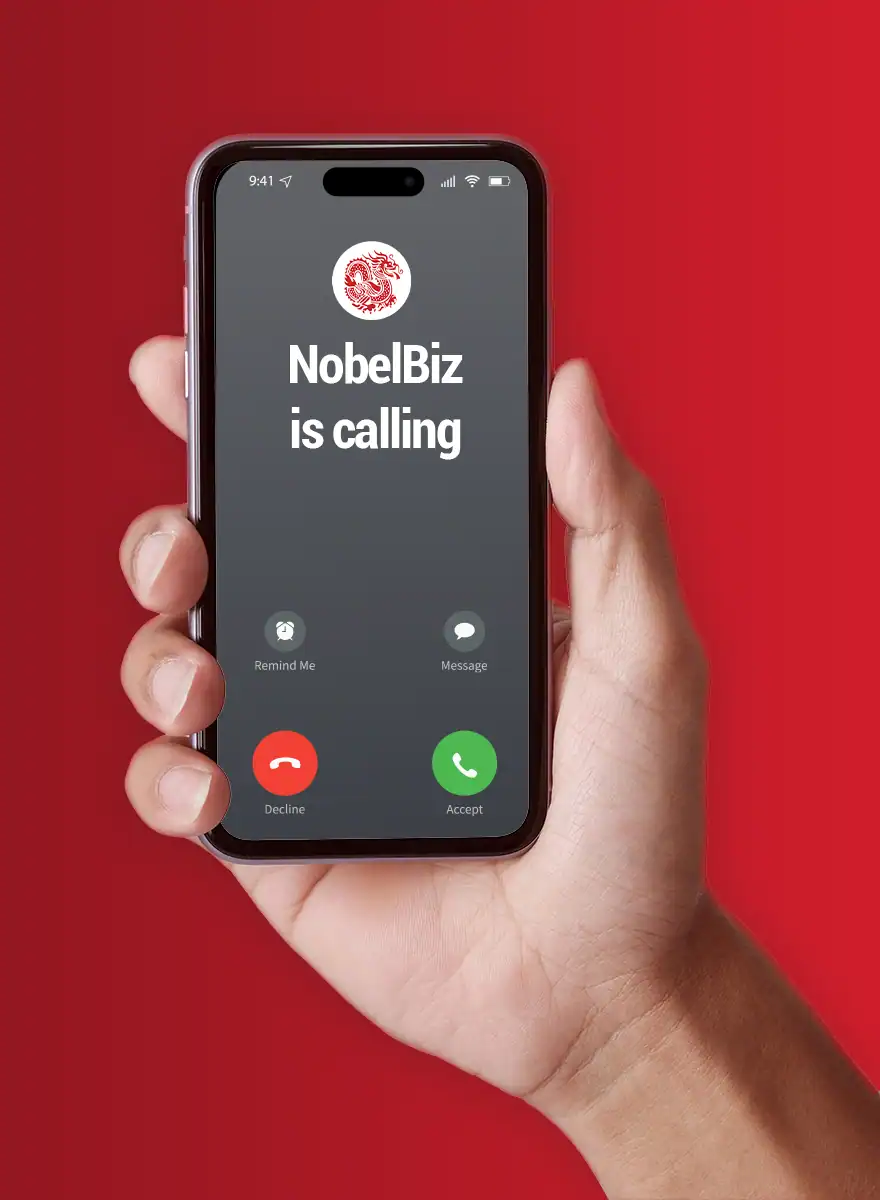If you manage a contact center today, ask yourself this:
How much control do you really have over your technology?
Can you easily switch vendors, adjust pricing when needed, or integrate new tools without friction?
Or does every change feel like you’re wrestling with your provider’s limitations?
- Vendor lock-in is the biggest hidden cost: It significantly hurts compliance and margins for contact centers in 2025.
- Contracts and proprietary systems create barriers: Long-term agreements, closed APIs, and locked ecosystems make switching vendors expensive and complex.
- Open-API, modular CCaaS platforms reduce risk: They support flexibility, easier migrations, and omnichannel software portability.
- Data and compliance portability are essential: They protect your business from regulatory and operational disruptions.
- Carrier and CCaaS separation increases flexibility: It ensures better pricing, control, and service continuity.
- NobelBiz OMNI+ unlocks true freedom: Flexible contracts, transparent pricing, and open integrations keep your contact center independent and scalable.
In 2025, the most significant hidden expense in the contact center industry isn’t hardware, software, or even compliance; it’s call center vendor lock-in.
Too many operations are tied to inflexible platforms, forced into multi-year contracts, and charged extra just to access their own data or connect with third-party systems.
This results in rising costs, slower innovation, and shrinking control over business-critical functions.
Contact center vendor dependency hurts more than budgets; it affects agility, compliance, and long-term growth. This leaves teams overpaying for restricted tech that can’t evolve with their needs. IBM’s software price hikes, up to 80% over the last decade, show how quickly reliance on one provider can become a financial burden.
In this blog, you’ll explore what vendor lock-in in call centers really means, how it happens, the risks it creates, and most importantly, how to avoid it through open integrations, flexible contracts, and more innovative vendor strategies that protect your margins and compliance readiness.
With third-party cookies disappearing, stricter consent laws, and consumers sharing less personal information, call centers must learn to do more with less—using first-party data, consent-driven outreach, and innovative compliance tools to keep their pipelines full.
Vendor Lock-In Risk Matrix
Here’s a quick breakdown of the most common vendor lock-in factors in call centers, how they happen, and the hidden risks they create for your operations and budget.
| Lock-In Factor | Description | Hidden Risk |
|---|---|---|
| Proprietary Technology | Custom dialers, CRMs, or APIs | High switching cost and integration limits |
| Data Ownership | Vendor controls call recordings and lead lists | Risk of losing access upon termination |
| Long-Term Contracts | 3–5 year CCaaS/BPO commitments | Expensive early-exit fees |
| Feature Bundling | Tied to unnecessary add-ons | Paying for unused functionality |
| Limited Integrations | Closed systems without APIs | Inflexibility with other platforms |
| Migration Complexity | Lack of data portability and transition planning | Downtime during changeover |
“Vendor lock-in isn’t a technology problem, it’s a business risk. The more freedom you build into your stack, the more control you keep over your future.” – Christian Montes, Chief Operating Officer at NobelBiz
What Is Vendor Lock-In in Call Centers?
Vendor lock-in occurs when your call center becomes overly dependent on a single provider for technology, software, or services, making it difficult or costly to switch.
It limits flexibility, drives up costs over time, and slows your ability to adapt when your needs change. These risks associated with proprietary contact center software become clear only when you attempt to migrate or integrate new tools.
How Does It Happen with Technology, Contracts, and Integrations?
Vendor lock-in usually starts small. You choose a tool or system that meets your needs. But over time:
-
Technology: Your entire setup, phones, CRMs, and reporting run on one platform. If you try to switch, you risk losing data or key functions. For example, you adopt a call routing system that only works with the vendor’s CRM. Replacing one means replacing both.
-
Contracts: Long-term contracts with high termination fees make it difficult to leave. For instance, a 3-year service contract that renews automatically can cost thousands to exit early.
-
Integrations: The deeper your systems connect with one vendor, the harder it is to move without breaking workflows. Custom APIs tie your ticketing system to your call platform, and switching vendors may mean rebuilding everything from scratch.
Once your data, call routing, and reporting are tightly bound to one provider, difficulty migrating data and integrations becomes your biggest obstacle.
Lock-in rarely happens overnight; it builds quietly as systems, processes, and contracts become interdependent.
Why Vendor Lock-In Hurts Agility, Innovation, and Margins?
When you can’t switch easily, you lose control over your growth and spending:
-
You can’t adapt quickly to new customer needs or technologies.
-
Vendors may stop improving features because they know you’re not going anywhere.
-
Costs creep up since you have fewer alternatives to compare or negotiate.
When your CCaaS platform slows your ability to innovate, that’s one of the most evident signs your CCaaS vendor is limiting flexibility.
The longer you stay locked in, the more flexibility and bargaining power you lose. In fact, 64% of businesses report that switching CCaaS providers is more challenging than expected. These numbers highlight the growing prevalence and cost of vendor dependency.
Common Forms of Dependency: Software, Carrier, Data, and Support
Vendor lock-in shows up in several ways. Recognizing them early helps you stay in control:
-
Your workflows, analytics, and scripts all rely on one platform. Switching means retraining your team and risking downtime. For example, using a single vendor for CRM, ticketing, and reporting, none of which integrate with external tools.
-
Your voice lines or numbers belong to the vendor, not you. Porting them elsewhere can take weeks or incur additional costs.
-
Your call logs, recordings, and customer data are stored in the vendor’s system, with limited export options.
-
You rely entirely on one company’s tech support, response times, and pricing. If their service quality drops, you have no backup option.
A lack of API flexibility or feature portability traps you into using tools that can’t integrate or evolve with your customer experience goals. Each dependency increases your reliance on a single provider, making flexibility harder and transitions more costly over time.
“Closed systems slow you down. Open integrations and carrier choice let you scale, adapt, and protect your margins without rebuilding your entire operation.” – Christian Montes, Chief Operating Officer at NobelBiz
The Hidden Costs of Vendor Dependency
Call center vendor lock-in quietly increases costs, slows innovation, and reduces your control over operations. Many contact center leaders realize too late that the real price of dependency shows up in contract renewals, migration barriers, and limited integrations.
Contract Renewals That Quietly Raise Pricing Tiers
You might start with a fair deal, but renewal time often brings a surprise: higher costs hidden behind “new pricing tiers.”
Vendors bundle features you don’t need, forcing you to pay more to keep basic access. Long-term contracts come with high termination fees, making it hard to negotiate better rates. Some CCaaS providers lock you into multi-year renewal cycles that automatically increase per-seat costs.
Always review renewal clauses. Always negotiate contract exit clauses that guarantee fair notice periods, full data export, and minimal termination fees.
Proprietary Systems That Make Migration Expensive
Proprietary platforms create what’s called CCaaS migration risk, where switching vendors means rebuilding your tech stack from scratch.
Closed APIs restrict integration with other tools, causing feature portability issues. Data formats and call routing logic differ across vendors, making migration complex and costly. Custom scripts or workflows tied to one system must be rebuilt on the new platform.
Choose vendors that support open integrations and multi-vendor ecosystems to protect your long-term flexibility.
Losing Access to Your Own Data After Contract Termination
Data dependency is one of the most frequently overlooked risks in selecting a contact center vendor. Once your contract ends, you may lose access to call logs, recordings, or historical metrics stored on the provider’s servers.
Some vendors restrict exports or charge extra for data retrieval. Others delete records after termination, creating compliance limitations. Without that data, benchmarking or customer journey analysis becomes impossible.
Always confirm data portability in your SLA. Ask how long your information remains accessible and in what format it can be exported.
How Limited Integrations Slow Down Omnichannel Performance
When your systems don’t communicate, both agents and customers feel the impact. Limited integration between voice, chat, and CRM tools directly affects omnichannel software portability and overall CX.
Agents switch between tools manually, increasing handle time. Inbound and outbound teams lose visibility across channels. You can’t automate key workflows, such as routing, reporting, or follow-ups.
Forrester found that 50% of contact centers cite integration limits as their top innovation blocker.
Avoiding vendor lock-in in contact centers starts with integration freedom. Prioritize platforms with open APIs and proven interoperability to maintain agility and innovation.
Early Signs You’re Already Locked In

Vendor lock-in often creeps in quietly. You might not notice it until switching vendors feels harder than staying put. If you’re seeing these signs in your call center operations, it’s time to take a closer look at your setup and contracts.
Your Provider Charges for Integrations or API Access
If your vendor treats integrations as “premium features,” you’re already dealing with a closed ecosystem.
-
Paying extra for API calls or CRM connections limits the flexibility of how you can utilize your own data.
-
Every time you want to connect a new tool, like your ticketing system or reporting dashboard, you’re billed again.
-
This kind of pricing locks you into the vendor’s ecosystem and discourages open integrations that support long-term flexibility.
A healthy CCaaS partnership encourages interoperability, not fees for every connection you make.
You Can’t Export Full Lead or Call Data Without Support Tickets
When exporting your own data requires manual approval or a service request, that’s a red flag.
-
You shouldn’t need vendor intervention to access call logs, recordings, or lead lists.
-
Some vendors throttle data exports or charge for “data dumps,” creating migration risks when you want to move to another provider.
-
This also raises compliance concerns, especially if you’re subject to data retention or audit requirements.
If you can’t retrieve data on demand, you don’t fully control it, your vendor does.
SLAs, Compliance Tools, and Analytics Are Tied to Proprietary Modules
Your vendor may bundle essential services, such as uptime guarantees or compliance monitoring, into their proprietary suite of offerings.
-
This means you can’t switch or integrate third-party tools for analytics, quality assurance, or workforce management.
-
It keeps you reliant on their roadmap and release cycles, slowing innovation and flexibility.
-
In some cases, compliance tools are tied to paid tiers, making regulatory readiness a recurring cost.
Critical operations, such as compliance and analytics, should never depend on a single vendor’s closed system.
Your Vendor Bundles “Core” Features You Rarely Use
Bundled pricing may sound efficient, but it often hides inefficiencies.
-
You might be paying for outbound modules, AI chat, or analytics dashboards that your team barely touches.
-
These “core” packages increase renewal costs and limit your ability to customize your tech stack.
-
When you try to scale down, the vendor tells you those features are “non-removable.”
True flexibility means paying only for what you need, not funding features that pad your vendor’s pricing tier.
Salman Aslam
Director Support – Quality & Training at WORK Inc.
‘The support team at Nobelbiz understood our business requirements and we we’re able to push through seamlessly’
How to Prevent Vendor Lock-In Before It Starts?
Vendor lock-in doesn’t happen by accident; it’s the result of small compromises made over time. You can prevent it before it ever becomes a problem. Here’s how to keep your call center agile, compliant, and ready to adapt as your business grows.
1. Demand Transparent Exit Clauses and Data Portability Rights
Before you sign anything, think about how you’ll get out. Contracts that look simple often hide restrictions when you try to leave.
-
Ask for clear exit clauses that outline fees, notice periods, and data retrieval timelines.
-
Ensure data portability rights are written into your agreement, not just “on request.”
-
Confirm that you can export full lead and call data in a usable format (CSV, JSON, etc.) without relying on vendor support.
For example, if your contact center negotiated an exit clause that required only 30 days’ notice and guaranteed full data delivery within 10 days, that would save weeks of downtime during migration. A flexible exit plan is your safety net. If your vendor hesitates to offer it, that’s a warning sign.
2. Choose Open-API and Modular CCaaS Platforms
If your tech can’t talk to other systems easily, you’re already limiting future choices. Open-API and modular CCaaS platforms give you control, rather than dependency.
-
Look for providers that publish their API documentation publicly, not behind paywalls.
-
Select platforms that allow you to add or remove modules (such as IVR, chat, and analytics) as your needs evolve.
-
Prioritize omnichannel software portability; your voice, chat, and CRM tools should sync seamlessly across all channels.
Openness today means freedom tomorrow. Closed systems might save setup time, but will cost you in flexibility later. Choosing open-API tools offers the benefits of open integrations and multi-vendor ecosystems, giving you flexibility and scalability without complete dependency.
3. Avoid Long-Term “Intro Pricing” Contracts That Double Later
Discounted “starter” deals often come with hidden strings. Once your intro period ends, prices jump, and long contract terms make it expensive to leave.
-
Avoid multi-year commitments unless pricing tiers are clearly locked for the full term.
-
Watch for bundled renewals that automatically shift you into higher usage brackets.
-
Negotiate shorter pilot terms before committing; it gives you leverage if the vendor underdelivers.
A low upfront cost shouldn’t trap you in high renewal fees. Flexibility should always outweigh discounts.
4. Build Your Stack with Interoperable Tools, Not All-in-One Traps
“All-in-one” sounds convenient, until you realize it means “all or nothing.” Instead, build a multi-vendor ecosystem where each tool serves a focused purpose.
-
Mix best-in-class tools for CRM, analytics, and workforce management that connect through APIs.
-
Avoid solutions that require using their entire suite to access basic features.
-
Design your stack around interoperability, so replacing one vendor doesn’t disrupt your entire workflow.
Interoperability is insurance against vendor dependency. Build a tech stack that gives you choice, not commitments.
Don’t let vendor contracts limit your growth. NobelBiz gives you the freedom to scale, switch, and save, with transparent pricing and no long-term lock-in.
Brayan Carpio
Senior Call Center Manager, Call4You Marketing
‘The technology aspect of NobelBiz stood out compared to the competition, and also the great team! All the way from onboarding to support to troubleshooting has been great throughout this journey!’
The Role of Compliance and Carrier Independence
Compliance and carrier flexibility are often overlooked in discussions about call center vendor lock-in; however, they’re critical.
When your compliance tools or carrier services are tied to one platform, you risk legal exposure, higher costs, and limited control over your operations. Let’s look at how to avoid those pitfalls.
Why Compliance Portability Matters in TCPA and STIR/SHAKEN Contexts?
Regulations such as the TCPA and STIR/SHAKEN require strict control over data and processes. If your compliance modules are built into a proprietary CCaaS platform, switching vendors could disrupt your compliance coverage overnight.
If call records and consent logs are stored in a closed system, exporting them for audits becomes a challenge. Losing STIR/SHAKEN compliance during migration can temporarily impact your call delivery rates and trust scores.
Some providers gate compliance tools behind premium tiers, forcing you to pay more for regulatory assurance. Ensure you can carry your compliance framework with you wherever you go.
How Carrier-Agnostic Voice Networks Prevent Dependency?
When your carrier is tied to your CCaaS vendor, you lose flexibility in pricing, routing, and redundancy. A carrier-agnostic setup allows you to select the best voice provider for each region or function, without requiring system rebuilds.
This aligns with the FCC’s 2024 proposal to reduce long-term carrier lock-in by promoting open competition and easier service switching, even across device and telecom ecosystems.
You can route traffic across multiple carriers for better uptime and call quality. If one carrier experiences downtime or price spikes, you can instantly switch without touching your CCaaS setup. As your call volume grows, carrier independence helps you negotiate better rates or add regional carriers without disruption.
Carrier-agnostic voice networks enable switching between contact center providers without downtime, ensuring continuity even during transitions. Carrier flexibility is a resilience strategy that maintains stable and cost-efficient operations.
The Cost Benefits of Separating Your Carrier and CCaaS Provider
Bundled solutions often sound appealing, offering a single vendor for both CCaaS and telephony. But in practice, this setup drives long-term cost dependency. Keeping your carrier and CCaaS provider separate gives you freedom.
-
You can compare carrier rates independently, avoiding inflated “all-in-one” billing.
-
You can switch carriers without renegotiating your entire CCaaS contract.
-
If your voice provider fails to meet SLAs, you can act quickly without interrupting platform access.
Separation gives you options. The more modular your setup, the easier it becomes to optimize costs and maintain service continuity.
“Compliance must travel with you. If you lose visibility into your data during a vendor switch, you’re not just locked in, you’re exposed.” – Christian Montes, Chief Operating Officer at NobelBiz
How NobelBiz Protects Clients from Lock-In
NobelBiz is built on freedom, flexibility, and interoperability. Here’s how NobelBiz keeps your operations free from long-term dependency:
1. Flexible Month-to-Month or Short-Term Agreements
You won’t be forced into a long-haul contract right off the bat. NobelBiz offers shorter-term or month-to-month agreements, providing you with the flexibility to test the solution without a long-term commitment. This reduces one of the significant risks of call centre vendor lock-in: being stuck with a provider when your needs change.
If your headcount changes or the campaign mix shifts, you can adjust without penalty or any lingering obligations.
Flexibility is built into the contract, not hidden behind it.
2. Open Integrations With CRM, Dialers, and Analytics Systems
NobelBiz’s platform is designed to integrate with your existing tools, rather than requiring you to replace everything. Their OMNI+ solution offers “rich selection of 3rd-party integrations” and “API integrations” for CRM, dialer, and analytics tools.
You maintain flexibility in your tech stack. If you decide to switch one component (say, your analytics engine), you’re not forced to overhaul the entire system.
Interoperability means your tools work for you — not against your freedom to adapt.
3. Transparent Pricing and Easy Onboarding/Off-Boarding
From voice-carrier to software, NobelBiz highlights “best-per-minute rates,” “fast no-hardware setup,” and a “plug and play” design. This helps you to make it clear how you get started and how you can exit.
You avoid hidden costs that often come with vendor dependence, like inflated termination fees or “you’re locked until year-end” clauses. You know what you’re paying, and you can leave if the service no longer meets your needs.
Transparency eliminates the surprises that cause dependency.
4. Separate Voice Carrier Network + OMNI+ Platform = Freedom of Choice
NobelBiz offers both a dedicated voice-carrier network and its cloud contact-center software (OMNI+). Because these functions can be decoupled, you aren’t forced to use one vendor for everything (software + telecom) if you don’t want to.
By separating the carrier and CCaaS platform, you reduce carrier dependency and avoid the classic all-in-one contract trap. If your telecom needs change (e.g., region, regulator, or voice volumes), you can choose a different carrier while keeping your software layer, or vice versa.
Decoupling gives you the power to optimize performance, cost, and compliance — independently.
Clinical Trial Media
Mo Pene |
Contact Center Technology Manager @ CTM
‘Thanks to NobelBiz, we now enjoy a robust, scalable communication system tailored to our growing needs, empowering us to deliver personalized care experiences more efficiently and boosting our overall revenue.’
Final Thoughts: Freedom Is the New Advantage
If your call center feels tied down by rigid contracts, limited integrations, or systems that can’t scale fast enough, you’re not the problem; your vendor is. Many leaders face the same frustration: paying more for less flexibility, waiting on support just to export data, or losing valuable uptime during migrations. These challenges slow your teams and drain margins, especially when compliance and performance are at stake.NobelBiz OMNI+ provides the proper foundation for avoiding vendor lock-in in contact centers. With flexible agreements, open integrations, transparent pricing, and the freedom to separate your Voice Carrier Network from the OMNI+ platform, you regain control of your operations.
Don’t get trapped in another long-term contract. Discover how NobelBiz gives call centers freedom, flexibility, and transparent pricing, with zero lock-in.Frequently Asked Questions
Discover how NobelBiz helps call centers maximize customer engagement, boost answer rates, and ensure compliance with industry-leading solutions.

Michael McGuire is a contact center industry expert with almost two decades of experience in the space. His experience includes roles as Director of Contact Center Digital Transformation at NobelBiz, and as Director of Operations at FLS Connect, managing multiple call centers. As President of Anomaly Squared and Targeted Metrics, Michael successfully transitioned companies into remote operations and significantly boosted revenues. With a strong background in customer service, leadership, strategic planning, and operations management, Michael excels in driving growth and innovation in the call center space.
Mike is also a proud Board Member for R.E.A.C.H Trade Group, promoting consumer protection and satisfaction and Co-host of the Off Skripted Podcast – a show about Life, Call Centers and everything in between.









